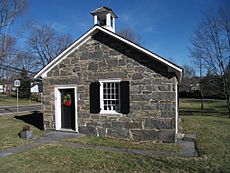Bedford Village Historic District facts for kids
Quick facts for kids |
|
|
Bedford Village Historic District
|
|

Bedford Firehouse and Bedford Free Library
|
|
| Location | Roughly bounded by Court, Seminary, Poundridge and Greenwich Rds., Bedford, New York |
|---|---|
| Area | 89 acres (36 ha) |
| Built | 1787 |
| Architectural style | Greek Revival, Gothic Revival |
| NRHP reference No. | 73001285 |
| Added to NRHP | October 2, 1973 |
The Bedford Village Historic District is a special area in Bedford, Westchester County, New York. It's like a time capsule, showing how a village looked long ago. This district has 80 important old buildings and one historic site. It covers most of the original village from 1680. The village was planned around a central green, which is a common design in New England.
Some famous buildings here include the court house (built in 1787) and the library (from 1807). There's also a school house (1829), a post office (around 1838), and a Presbyterian church (1872). These buildings are great examples of Greek Revival and Gothic Revival styles. Two of these old buildings are now museums you can visit!
Contents
Discovering Bedford Village
Bedford is about 44 miles northeast of New York City. The first settlers came from Connecticut around 1680. They built a small village here. The way the town was planned is very common in Massachusetts. But it is quite rare for New York State.
The town was designed around a triangular common area. This is where three roads met. The first 20 settlers planned to farm together. This idea didn't last long. But it shaped how Bedford looked. It became an important market town.
A Look Back in Time
Bedford was once a county seat during the American Revolutionary War. This means it was a center for local government. It even had a county court house until 1870. The village green is still surrounded by many historic buildings. These include the court house from 1787 and the Historical Hall from 1806. There's also a library, which used to be the Bedford Academy.
A school house built from stone dates back to 1829. You can also see a post office and a general store from around 1838. The beautiful Presbyterian church in Gothic Revival style was built in 1872. These buildings make Bedford look like a classic New England village.
Bedford was under Connecticut's control until 1700. Then, King William ordered it to become part of New York State. The Westchester County Historical Society says the Bedford Village Historic District is very important. It shows a unique "colonial New England pattern" in New York. During the Revolutionary War, it was a center for resistance. It also served as a supply center. After the war, many new buildings were built. These included Federal style, Greek Revival style, and Victorian style buildings. Bedford was a busy farming and trading center for a long time.
The district was added to the National Register of Historic Places in 1973. The Bedford Historical Society now runs two museums. One is in the old court house. The other is in the former school house.
Important Buildings
The Old Court House (1787)
The court house was built in 1787. It is the oldest government building in Westchester County. It's also one of only three court houses in New York State built before 1800. This building was used when Bedford was the county seat. This was from 1788 to 1870.
Many important people worked here. Judges like William Jay served in the court room. He was the son of John Jay, the very first chief justice of the United States. Lawyers like Aaron Burr also practiced here. Aaron Burr later became vice president.
The court house has been restored several times. It was fixed up in 1889 and again from 1965 to 1970. Today, it is a museum for the Historic District. It also hosts lectures and meetings. Sometimes, people even perform mock trials in the courtroom!
The Stone School House (1829)
The school house was built quickly in 1829. It had just one room. In this room, students learned many subjects. These included grammar, spelling, math, history, and geography. They also studied the Bible. If the teacher knew enough, they might even learn Latin and philosophy!
The school had a library too. In 1843, its books covered history, travel, and science. There were also books about farming, biographies, and literature. In 1842, 62 children attended the school. But many only came for four or five months.
By 1912, the school was too small. The building then became a museum. It was founded by the Bedford Agassiz Society in 1913. The Bedford Historical Society has run it since 1918. In 1970, the school became a special exhibit. It teaches visitors about history.
The Presbyterian Church (1872)
The Presbyterian Church on the village green was built in 1872. It is the fourth church building on this spot. The first minister, Reverend Thomas Denham, arrived in 1684. A meeting house was built in 1689. When Bedford became part of New York, this building was moved.
The second meeting house was burned by the British in 1779. A third building was later moved to Westmoreland Sanctuary. The beautiful fourth church was then built in 1872.






